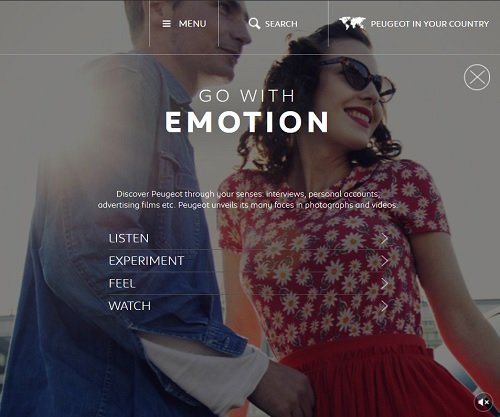Want to avoid becoming a breakthrough brand? There are plenty of ways to send out weak signals. Or even to sabotage your brand.
At Sixième Son, we work with 35 to 50 brands a year. That gives us extraordinary chance to see the good, the bad, and the ungainly aspects of branding.
Make the following brand mistakes, and you will definitely avoid success.
1. Be mono-sensory
Most brands have defined their visual identities, which are held in place with the help of their graphic guidelines (and no small amount of willpower).
But in a world of constant distraction, brands need to use every tool in their sensory kit to be perceived and remembered.
Coca-Cola is masterful at suggesting multiple senses even when the company is only in the visual realm. The brand is especially skilled at evoking the sensation of cold. The simplest sign on the wall of a bodega or an ordinary soda dispenser uses graphic condensation droplets to create the anticipation of iciness.
Sometime in visuals, Coca-Cola goes beyond temperature to suggest a sound
Those are silent but evocative ways to stimulate the senses.
Still, as much as marketers know they need to take steps to engage the senses, they often leave sound, smell, and touch by the wayside. And few brands have style guides to govern sound or scent.
Not all brands have the luxury of sharing the natural scents of Cinnabon or Starbucks, but many that do don’t guard their scents as rigorously. For example, in regards to Cinnabon, the Wall Street Journal reports, “Some store operators heat additional sheets of brown sugar and cinnamon to keep the aroma in the air.”
Another example: Starbucks once removed breakfast sandwiches for a six-month retooling because they tainted the signature scent of the store.
And brands beyond restaurants are adopting scents. Delicate tea-based fragrances grace a hotel chain or high-end apartment building, for instance. Retailers may add homey scents.
Most companies neglect to create clear multi-sensory style guides to help keep the company’s image on track. For example, brands have the opportunity to codify their brand guidelines for scent.
Even brands that don’t have their own retail spaces can connect with audiences via the powerful auditory sense by using a custom-tailored audio brand to distinguish their appeal through trade shows, on-hold music, website, online videos, apps, and sampling events.
To stand out from the flurried background, and to be well understood, today’s brands must define ownable footprints in multiple sensory modes.
2. Be unemotional
If you’re hard to relate to, you’ll be hard to remember. And if you base your brand on rational benefits alone, you’ll also be hard to relate to.
Many brands claim to be the leader (local, national, or global) in their categories without letting prospects know what emotional benefit they’re offering. Will the audience feel more confident? Will they enjoy the pride of looking smart to their colleagues? Will they relish the comfort of sleeping well at night?
Confidence, pride, or comfort can be expressed viscerally in branded music, which speaks a language that all can understand—and which is exceptionally good at evoking specific emotions.
You can see this in the auto category, where Peugeot has just stepped away from the metallic and machine-like audio codes of the category and plugged into the emotion you feel when you drive their precise and elegant autos.
The melody’s crystal clarity expresses the uncompromising standards of the brand. The futuristic sound design and the rhythm section convey the concepts of modernity and movement while the airy female voice, reflects sensuality and driving pleasure.

In two detailed international studies, research showed that the audio identity had reached 64% recognition and had improved brand perception by 33% among the respondents in five countries around the world.
B2B brands often err on the side of the rational and the visually oriented. Energy companies, construction equipment, consultancies, and the like get tricked into thinking that decision-making is rational.
They eschew the more emotional and sensual side of brand relationships. Sometimes, that changes when new competition appears.
3. Have conflicting images
Are you conveying a particular impression at one touchpoint then presenting yourself so differently at another that people can’t believe it is the same company?
A brand can be both technically excellent and warm. It can be both diverse and hospitable. But you can’t be a credible neighborhood bank and a global institution. You can’t sell artisanal craftsmanship and mass-market consistency.
Moreover, your brand can have auditory conflicts, too.
When I was buying a microwave, I figured that Samsung must have a sensitivity to sound because its Galaxy mobile phone had such a simple and sophisticated ringtone. I couldn’t hear its signals in the store, and I chose a Samsung. The first time I used it though, much to my surprise, the end was announced by a high-pitched BEEP, BEEP, BEEP.
Your brand (and your audio brand) can evolve as long as its core values remain the same. SNCF designed its audio brand when it was first faced with competition. Since then, the company has updated it twice: once to emphasize an eco-friendly message and a few years later, to focus on ease and convenience.
Though the instrumentation and sound effects altered, the warm caring tune stayed the same.
4. Be inconstant
Changing your brand too often, means you don’t have a brand.
Sears has suffered from inconstant branding, stumbling from appliances and hardware to the “softer side” and now to the vague promise, “More to you,” focusing on sub-brands and partner brands like Craftsman, Kmart, and Land’s End. Retail industry expert Barbara Farfan says, “The Sears brand isn’t the most patriotic, it’s not the most green, and it’s definitely not the most valuable.”
Another way brands can be inconstant is to present themselves to employees one way and present themselves to their consumers a different way.
5. Be comprehensive
The essence of branding is sacrifice. If it takes 30 pages to define your brand, it means it is undefined or yet-to-be-defined. This makes for a tepid brand.
Your potential and existing customers are unclear about who you are–and who you are not.
* * *
Find your focus. Disseminate it via every sensory path you have. Create your multisensory style guide, and reap the rewards.


